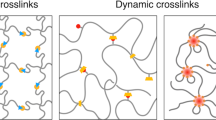Abstract
A power law distribution of relaxation times, large normal stress differences, and physical rupture of molecular network strands dominate the shear behavior of polymers at the gel point (critical gels). This is shown in a series of well-defined experiments with increasing magnitude of shear on a model-network polymer system consisting of a linear, telechelic, vinyl-terminated poly-dimethylsiloxane (PDMS) and a four-functional siloxane crosslinker. Stable samples were prepared by stopping the crosslinking reaction at different extents of reaction in the vicinity of the gel point (GP). The Gel Equation has been shown to be valid up to strains of about 2 when using a finite strain tensor. Larger strains have been found to disrupt the network structure of the crosslinking polymer, and introduce a mechanical delay to the gel point. A sample that was crosslinked beyond the gel point (p>p c ) can be reduced from the solid state to a critical gel, or even to a viscoelastic liquid, depending on the magnitude of shear strain. As a consequence, the relaxation exponent of a critical gel created under the influence of shear is less than that of a quiescently crosslinked critical gel.
Similar content being viewed by others
References
Chambon F, Winter HH (1985) Polym Bull 13:499 Winter HH, Chambon F (1986) J Rheol 30:367 Winter HH (1987) Progr Coll Polym Sci 75:104 Winter HH (1989) “Gel Point”, in supplement to “Encyclopaedia of Polymer Science and Engineering”, 2nd ed, Kroschwitz JI, Bikales N (eds) Wiley, New York, p 343
Chambon F, Winter HH (1987) J Rheol 31:683
Holly EE, Venkataraman SK, Chambon F, Winter HH (1988) J Non-Newtonian Fluid Mech 27:17
Scanlan JC, Winter HH (1990) Macromol, in press
Martin JE, Adolf D, Wilcoxon JP (1957) ACS Polym Prepr 30(1):83 (1989), and Phys Rev A, 36:1803
Rubinstein M, Colby RH, Gillmor JR (1989) ACS Polym Prepr 30(1):81
te Nijenhuis K, Winter H (1989) Macromol 22:411
Durand D, Delsanti M, Adam M, Luck JM (1987) Europhys Lett 3:297
Lodge AS (1964) Elastic Liquids, Academic Press, New York
Larson R (1987) Constitutive Equations for Polymeric Liquids and Solutions, Butterworths, Boston
Baumgaertel M, Winter HH (1989) Rheol Acta 28:511
Venkataraman SK, Coyne L, Chambon F, Gottlieb M, Winter HH (1989) Polymer 30:2222
Valles EM, Macosko CW (1979) Macromol 12:521
Chambon F (1986) Ph D dissertation, Univ of Mass
Fischer A, Gottlieb M (1986) Proc of Networks '86. Elsinor, Denmark
Antonietti M, Folsch KJ, Sillescu H, Pakula T (1989) Macromol 22:2812
Walsh R (1981) Acc Chem Res 14:246
Macosko CW, Miller DR (1976) Macromol 9:199 and 206
Author information
Authors and Affiliations
Rights and permissions
About this article
Cite this article
Venkataraman, S.K., Winter, H.H. Finite shear strain behavior of a crosslinking polydimethylsiloxane near its gel point. Rheol Acta 29, 423–432 (1990). https://doi.org/10.1007/BF01376793
Received:
Revised:
Issue Date:
DOI: https://doi.org/10.1007/BF01376793



